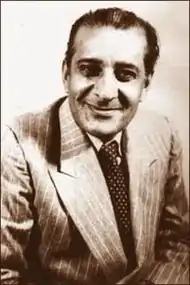Malik Ghulam Muhammad
Sir Malik Ghulam Muhammad CIE (Urdu: ملک غلام محمد; 20 April 1895 - 29 August 1956), was a Pakistani politician and financier who served as the third Governor-General of Pakistan, appointed in this capacity in 1951 until being dismissed in 1955 due to health conditions.[1] He co-founded Mahindra & Mohammed in 1945 (later Mahindra & Mahindra in 1948) with Jagdish Chandra Mahindra and Kailash Chandra Mahindra.
Sir Ghulam Muhammad | |
|---|---|
ملک غلام محمد | |
 | |
| 3rd Governor-General of Pakistan | |
| In office 17 October 1951 – 7 August 1955 | |
| Monarch | George VI Elizabeth II |
| Prime Minister | K. Nazimuddin M. A. Bogra |
| Preceded by | K. Nazimuddin |
| Succeeded by | Iskander Mirza |
| 1st Minister of Finance | |
| In office 15 August 1947 – 19 October 1951 | |
| Prime Minister | Liaquat Ali Khan K. Nazimuddin |
| Deputy | Muhammad Ali (1947-48) Victor Turner (1948-51) |
| Preceded by | State proclaimed |
| Succeeded by | Muhammad Ali |
| Personal details | |
| Born | Malik Ghulam Muhammad August 29, 1895 Lahore, Punjab, British India (Present-day Pakistan) |
| Died | August 29, 1956 (aged 61) Lahore, West Pakistan, Pakistan |
| Resting place | Gora Qabrastan (Christians) near CSD off Shahra-e-Faisal Karachi |
| Citizenship | |
| Political party | Independent |
| Spouse(s) | Badshah Begum |
| Children | Two |
| Alma mater | Aligarh Muslim University (BA in Acc.) |
| Occupation | Civil servant, Chartered Accountant |
| Awards | |
Educated at the Aligarh Muslim University (AMU), he joined the Indian Civil Service as a chartered accountant at the Indian Railway Accounts Service before being promoted to join the Ministry of Finance under Liaquat Ali Khan in 1946. After the Independence of Pakistan in 1947, he joined the Liaquat administration as the country's first Finance Minister where he helped draft the first five-year plans to alleviate the national economy.
Following the assassination of Prime Minister Liaquat Ali Khan in 1951, he was invited to be the Governor-General by Khawaja Nazimuddin who himself took over the government as Prime Minister. Nationwide violence as the aftermath of the language movement in Dacca and religious riots in Lahore made him dismiss Nazimuddin administration using the reserve powers to restore control of the Law and order in Pakistan. In 1955, he was forced to resign from the post of Governor-General due to worsening of his health conditions by then-Interior Minister Iskander Ali Mirza, who himself took control of the office. After resignation, he fought a brief but unsuccessful battle with his illness, that ultimately resulted in his death in 1956.
His personal image is viewed negatively by Pakistan's historians, criticized for giving rise to political intrigue, undermining the civilian control of the military by authorizing the Martial law in Pakistan, and devaluing nascent democratic norms by sacking the Constituent Assembly of Pakistan during Prime Minister Bogra's tenure.[1]
Biography
Family background and education
Malik Ghulam Muhammad was born in a Kakazai family, in suburban neighborhood near Mochi Gate, in Lahore, Punjab, India.[2][3][4][5][6]:xxx After completing his schooling in Lahore, he went to Aligarh in Uttar Pradesh to attend the MAO College of the Aligarh Muslim University (AMU), and was a roommate of Nazir Ahmed, a physicist and a bureaucrat.[7] At AMU he gained a BA degree in accountancy.[8]
Civil service and business interests
After graduating from AMU, he joined the Audit and Accounts Service in March 1920.[9][10][11]:630 In January 1921, he received his first official appointment as assistant audit officer with the Oudh and Rohilkhand Railway.[9] Upon its merger into the East Indian Railway in 1925, Muhammad was briefly appointed a government executor of accounts with the Bengal and North Western Railway, serving in this capacity from January to November. Having earned a reputation as an able and competent accountant, he was then appointed to the Indian Railway Board before becoming the Controller of General Supplies and Purchase of the Indian Railways.[11]:274–275 From June 1932 to February 1934, he was attached to the administration of Bhopal State, and worked under its nawab, Hamidullah Khan.[9] In March 1934, he returned to government service and was appointed deputy accountant-general (posts and telegraphs); in May, he was appointed as officiating deputy director-general (posts and telegraphs, finance), and was confirmed in the appointment in January 1935.[9] In July 1936, he was appointed as officiating financial officer in the same department, was confirmed in his appointment in April 1937 and was promoted to financial officer (communications) in October.[9]
Following the outbreak of the Second World War, Muhammad was successively appointed to increasingly important positions: chief controller of stores in March 1940, controller-general of purchase in September 1940 and additional secretary to the Department of Supply in March 1941.[9] His wartime services as a professional accountant were recognized by the British government that year when he was appointed a Companion of the Order of the Indian Empire (CIE) in the 1941 Birthday Honours list.[12] In May 1942, Muhammad was assigned to the Hyderabad State administration,[9] in which he served as an advisor to the Nizam of Hyderabad.
In 1945, he helped co-found the Mahindra and Mohamed Steel Company together with steel industrialists, JC Mahindra and KC Mahindra where Muhammad served the company's chartered accountant.[13] In 1945–47, the company initially registered as the Mahindra & Mohammad, and started the licensed production of the Willys jeeps in Bombay as Muhammad looked after the company's revenue and finances.[14]
After World War II, he was asked by Nawab of Bahawalpur, Lord Sadeq Mohammad Khan V to represent him at the Round Table Conferences, and during this time, he began formatting political relations with Liaquat Ali Khan.[15] He left Hyderabad left to join the Ministry of Finance in 1946.[15] In the 1946 King's Birthday Honours List, the last honours list in which Indian civil servants were recognised, he received a knighthood.[16]
Finance Minister (1947–51)
In 1946–47, Muhammad left Mahindra & Mahindra and joined the Ministry of Finance as a Cabinet Secretary under Finance Minister Liaquat Ali Khan, assisting him in drafting and preparing India's first union budget.[15]
After witnessing the Partition of India in 1947, he decided to acquire the citizenship of Pakistan and permanently settled in his native city, Lahore, on 14 August 1947.[15] He was brought up in the Liaquat administration when Prime Minister Liaquat Ali Khan appointed him as country's first Finance Minister.[15] He presented the first budget and submitted the draft of the First Five-Year Plans in 1948.[15]
In 1949, Muhammad invited leaders of the Muslim world to the International Islamic Economics Organization in Pakistan, where he emphasised the idea of a Muslim economic bloc.[15] During this time, he survived the fatal attack of paralysis that made him unable to talk or move effectively and began suffering with poor health conditions.[17][15]
Governor-General (1951-55)
As early as 1951, Prime Minister Liaquat Ali Khan had made a decision of removing Finance Minister Muhammad due to his continuing worsening health conditions.[15] However, the decision was not taken due to the assassination of Prime Minister Liaqat Ali Khan in October 1951.[15] Governor-General Khawaja Nazimuddin nominated him in his capacity while taking control over the government as the Prime Minister, appointing his own cabinet.[15]
In 1953, he represented Pakistan at the Coronation of Elizabeth II in Westminster Abbey alongside the Governors-General from Canada, Australia, New Zealand, South Africa and Ceylon.[18] Upon returning to Pakistan, he witnessed the agitation caused by the language movement in Dacca in East Pakistan, and the series of anti-Qadiyani protests in Lahore, Punjab in Pakistan. Both events led him to use the reserve powers awarded by the Government of India Act 1935 against Prime Minister Nazimuddin, effectively dismissing his administration only to be replace with diplomat M. A. Bogra.[19]:118–119
In 1954, the Constituent Assembly made legislative attempts to try changing the 1935 act to establish checks and balances on the Governor-General's powers.[20]:236 In response, Muhammad again dismissed the Constituent Assembly, an action that was challenged in the Sindh High Court by Maulvi Tamizuddin, the Speaker of the Assembly.[19]:118–119 The Sindh High Court's Chief Justice Sir George Constantine ruled the Governor-General's decision illegal, but the ruling was overturned by Supreme Court of Pakistan, led by Chief Justice Muhammad Munir, in a split decision.[19]:119–121
Historians consider this action the beginning of viceregal politics in Pakistan, in which the military and civil bureaucracy, not elected officials, would gain increasing influence over the country's policymaking.[21]
During this time, his health began to deteriorated as paralysis spread in his whole body, forcing him to take a leave of absence to seek treatment in the United Kingdom in 1955.[15] In his capacity, he appointed Interior Minister Iskander Mirza as acting Governor-General but Mirza dismissed him from his post in order to take his place, supported by the Constituent Assembly's legislators.[15]
Death
.jpg.webp)
On 29 August 1956, Malik Sir Ghulam Muhammad died and was buried in Karachi in Gora Qabrastan, Christian's Graveyard, next to Fauji Qabristan.[8][15]
See also
- Monarchy of Pakistan
- Pakistani billionaires
References
- Ghulam Muhammad - Story of Pakistan, Retrieved 8 June 2017
- Rahi, Arwin (25 February 2020). "Why Afghanistan should leave Pakistani Pashtuns alone". The Express Tribune. Retrieved 26 June 2020.
- "Malik Ghulam Muhammad - Governor-General of Pakistan". Pakistan Herald. 23 July 2017. Retrieved 9 August 2020.
- "Ex Gov.Gen. Ghulam Muhammad's 54th death anniversary today". Samaa TV. Retrieved 9 August 2020.
- Sheikh, Majid (22 October 2017). "The history of Lahore's Kakayzais". DAWN.COM. Retrieved 28 February 2018.
- Kumarasingham, H. (2016). "Bureaucratic Statism". Constitution-making in Asia: Decolonisation and State-Building in the Aftermath of the British Empire (1 ed.). U.S: Routledge. ISBN 978-1-317-24509-4.
- Rizvi, H. Military, State and Society in Pakistan. Springer. p. 259. ISBN 978-0-230-59904-8.
- "Ex-Governor General Ghulam Mohammad's anniversary today". Samaa TV. 29 August 2012. Retrieved 24 March 2017.
- The India Office and Burma Office List: 1945. Harrison & Sons, Ltd. 1945. p. 199.
- Malik, I. State and Civil Society in Pakistan: Politics of Authority, Ideology and Ethnicity. Springer. p. 26. ISBN 978-0-230-37629-8.
- Raza, Syed Hashim (1991). Hamari Manzil. Karachi, Pakistan: Mustafain & Murtazain. ISBN 978-969-460-002-4.
- "No. 35184". The London Gazette (Supplement). 6 June 1941. p. 3285.
- Jacobs, A. J. (2016). "Mahindra&Mahindra in North America". The New Domestic Automakers in the United States and Canada: History, Impacts, and Prospects. New York: Lexington Books. p. 334. ISBN 978-0-7391-8826-2.
- Mahindra, Mahindra. "Mahindra's history - Mahindra Rise". www.mahindra.com. Mahindra. Retrieved 24 March 2017.
- "Ghulam Muhammad--Former Governor General of Pakistan". Story Of Pakistan. Lahore, Pakistan: Nazaria-e-Pakistan Trust. 21 October 2013. Retrieved 24 March 2017.
- "No. 37598". The London Gazette (Supplement). 4 June 1946. p. 2757.
- Balouch, Akhtar (3 October 2014). "Graves laden with sweets". Dawn. Retrieved 24 March 2017.
- "Malik Ghulam Muhammad". prideofpakistan.com. Retrieved 25 March 2017.
- Chak, Farhan Mujahid (2015). "The Constitutional cases". Islam and Pakistan's Political Culture (1 ed.). New York: Routledge. p. 180. ISBN 978-1-317-65794-1.
- Siddique, Osama (2001). "Approaches to legal and judicial reforms in Pakistan". Pakistan's Experience with Formal Law: An Alien Justice. Cambridge University Press. p. 451. ISBN 978-1-107-03815-8.
- "The New Dictatorship". Time. 8 November 1954. Retrieved 8 June 2017.
External links
| Political offices | ||
|---|---|---|
| New office | Minister of Finance 1947–1951 |
Succeeded by Chaudhry Muhammad Ali |
| Preceded by Khawaja Nazimuddin |
Governor-General of Pakistan 1951–1955 |
Succeeded by Iskander Mirza |
